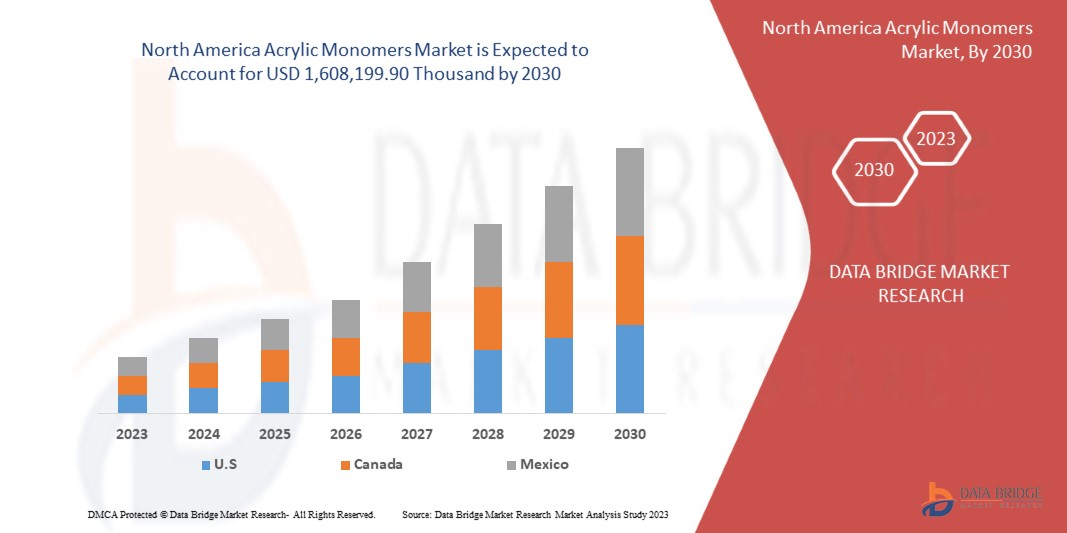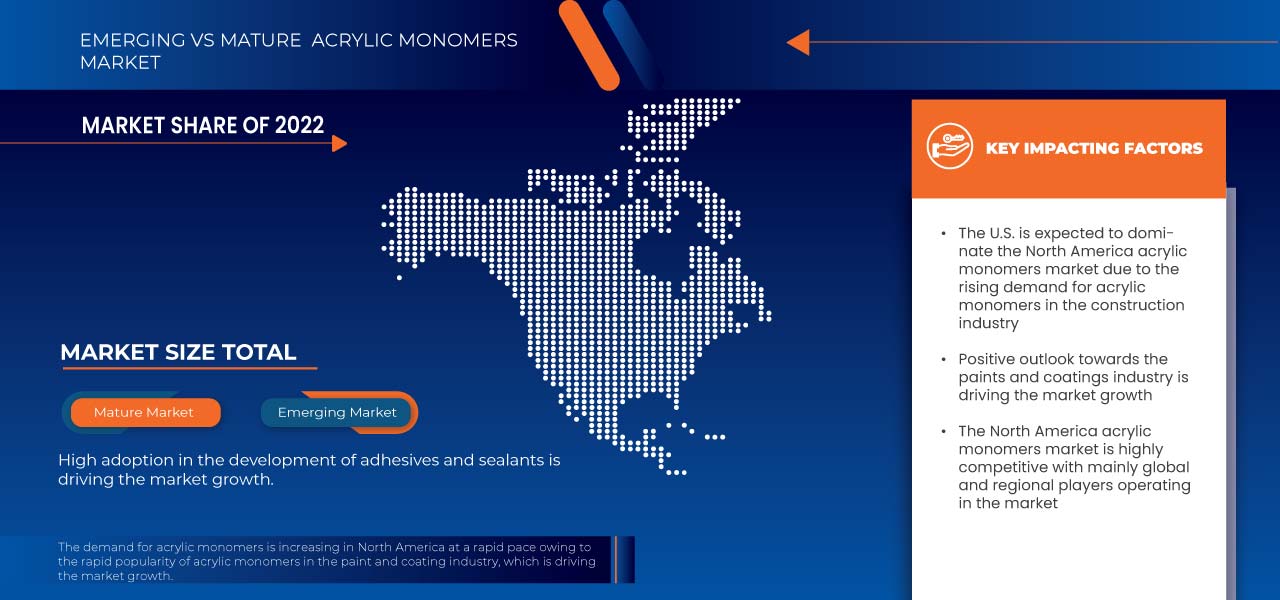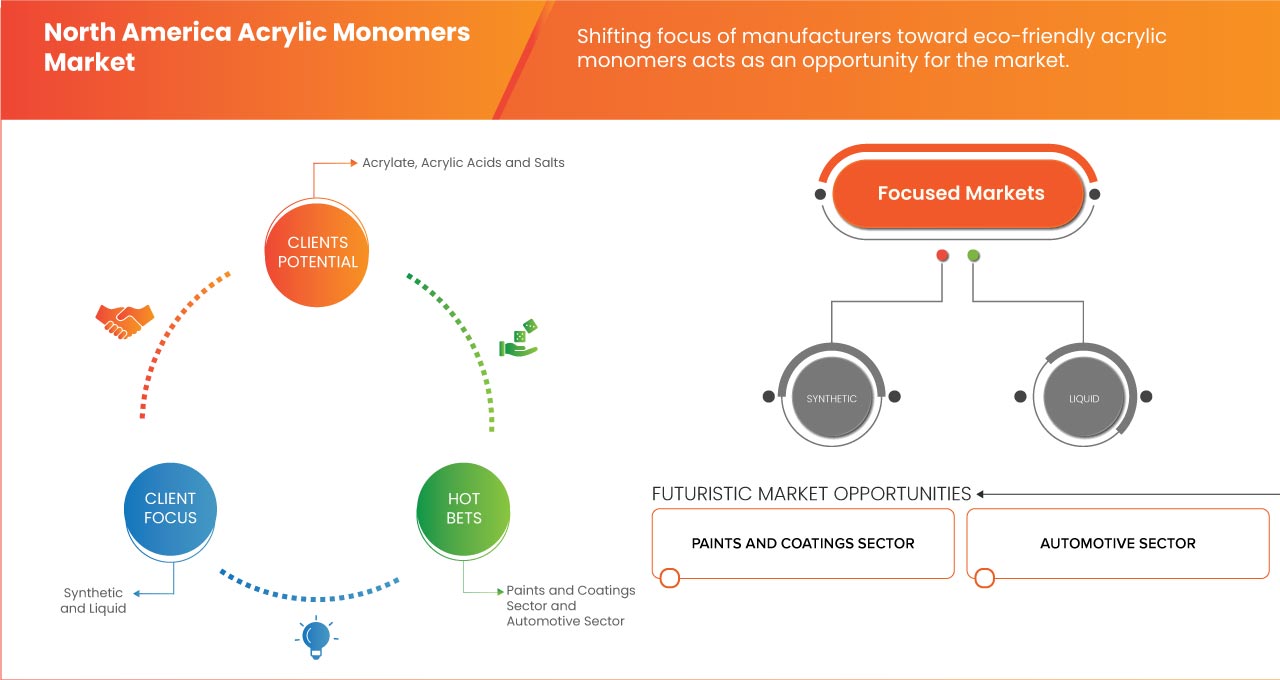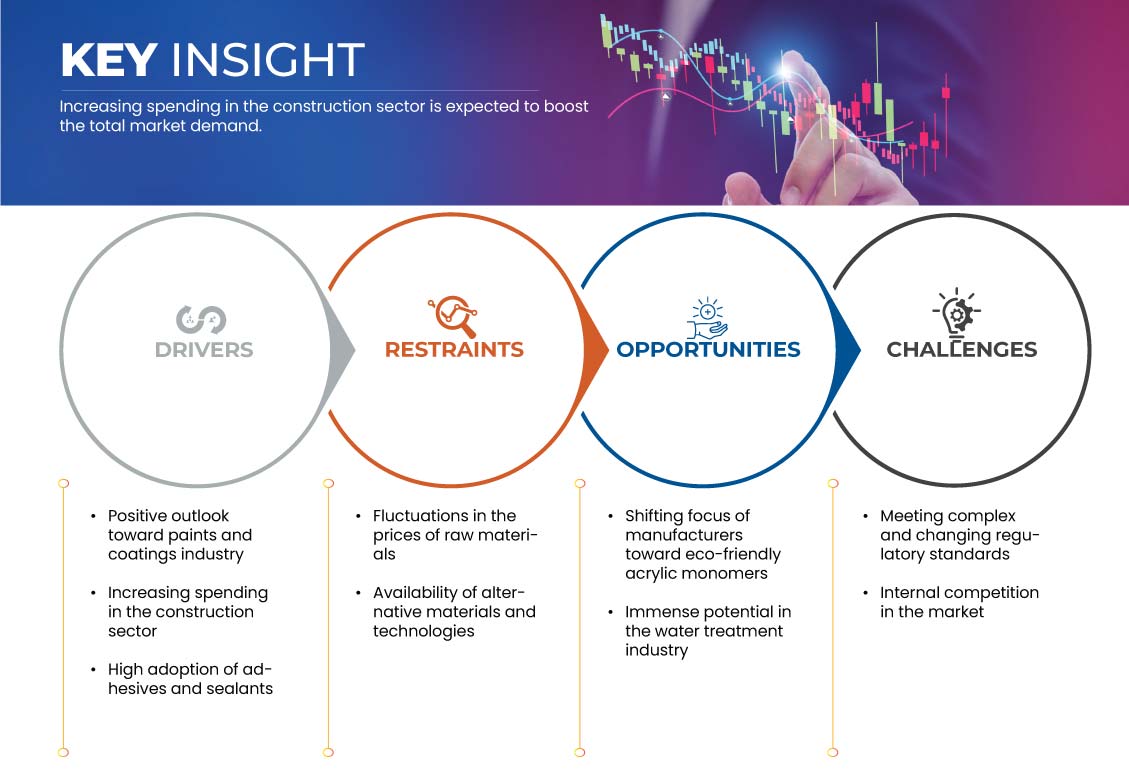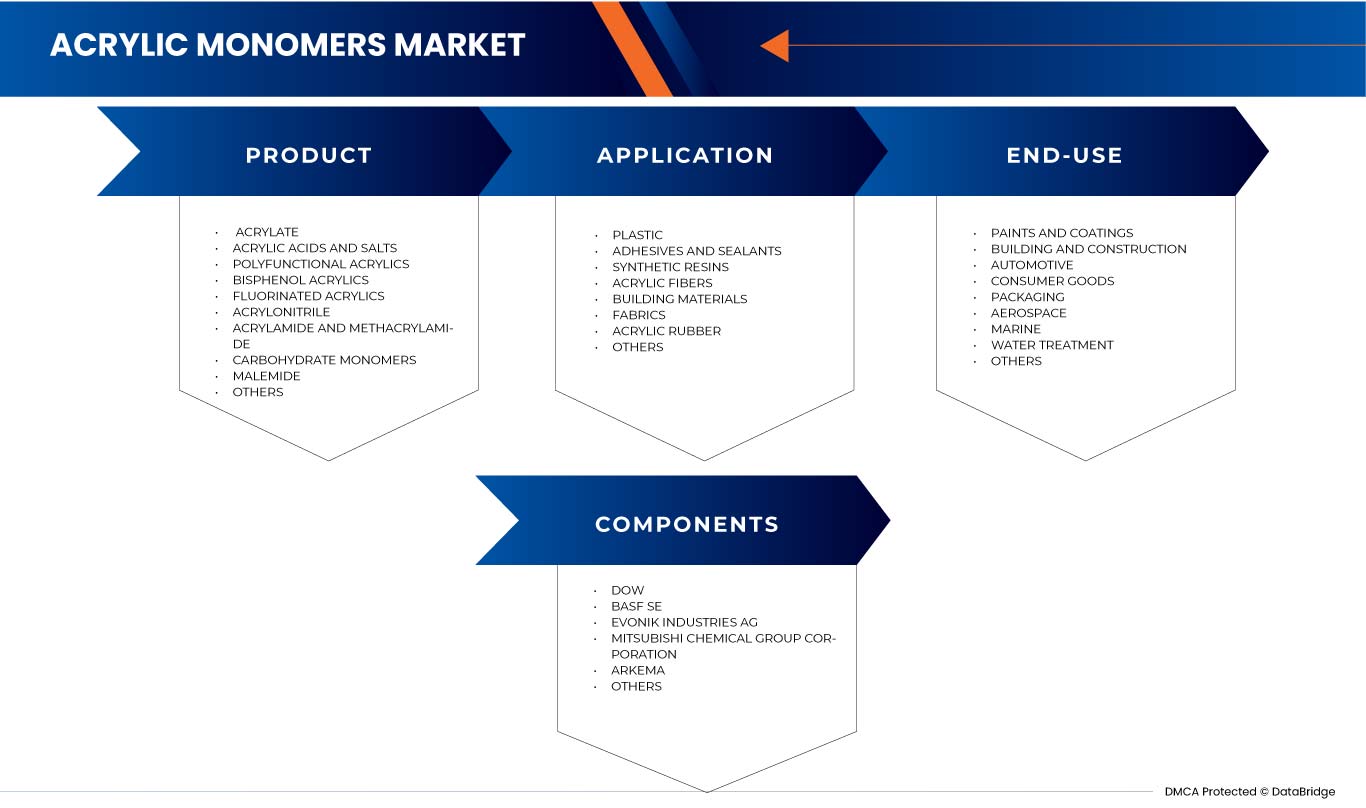North America Acrylic Monomers Market
Taille du marché en milliards USD
TCAC :
% 
| 2023 –2030 | |
| USD 1,107,202.15 Thousand | |
| USD 1,608,199.90 Thousand | |
|
|
|
Marché des monomères acryliques en Amérique du Nord, par produit (acrylate, acides et sels acryliques, acryliques polyfonctionnels, acryliques bisphénoliques, acryliques fluorés, acrylonitrile, acrylamide et méthacrylamide, monomères glucidiques, malémide et autres), application (plastique, adhésifs et produits d'étanchéité, résines synthétiques, fibres acryliques, matériaux de construction, tissus, caoutchouc acrylique et autres), utilisation finale (peintures et revêtements, bâtiment et construction, automobile, biens de consommation, emballage, traitement de l'eau, marine, aérospatiale et autres) - Tendances et prévisions de l'industrie jusqu'en 2030.
Analyse et taille du marché des monomères acryliques en Amérique du Nord
Le marché nord-américain des monomères acryliques est stimulé par l'augmentation des dépenses dans le secteur de la construction. En outre, les perspectives positives concernant l'industrie des peintures et des revêtements constituent un moteur important pour le marché. De plus, l'orientation des fabricants vers les monomères acryliques respectueux de l'environnement devrait stimuler la croissance du marché. Cependant, le respect de normes réglementaires complexes et en constante évolution devrait freiner la croissance du marché.
Data Bridge Market Research analyse que le marché nord-américain des monomères acryliques devrait atteindre 1 608 199,90 milliers USD d'ici 2030, contre 1 107 202,15 milliers USD en 2022, avec un TCAC de 4,9 % au cours de la période de prévision de 2023 à 2030.
|
Rapport métrique |
Détails |
|
Période de prévision |
2023 à 2030 |
|
Année de base |
2022 |
|
Années historiques |
2021 (Personnalisable 2015-2020) |
|
Unités quantitatives |
Chiffre d'affaires en milliers de dollars américains, volume en milliers de litres |
|
Segments couverts |
Produit (acrylate, acides et sels acryliques, acryliques polyfonctionnels, acryliques bisphénoliques, acryliques fluorés, acrylonitrile, acrylamide et méthacrylamide, monomères glucidiques, malémide et autres), application (plastique, adhésifs et produits d'étanchéité, résines synthétiques, fibres acryliques, matériaux de construction, tissus, caoutchouc acrylique et autres), utilisation finale (peintures et revêtements, bâtiment et construction, automobile, biens de consommation, emballage, traitement de l'eau , marine, aérospatiale et autres) |
|
Pays couverts |
États-Unis, Canada et Mexique |
|
Acteurs du marché couverts |
BASF SE, Arkema, Mitsubishi Chemical Group Corporation, Dow, LG Chem, Evonik Industries AG, NIPPON SHOKUBAI CO., LTD., LobaChemie Pvt Ltd., Solventis et Tokyo Chemical Industries CO., Ltd. |
Définition du marché
Les monomères acryliques sont constitués de composés qui englobent l'acide acrylique et ses acrylates associés. Ces composés constituent principalement des acrylates, de l'acide acrylique ou des polymères. Les monomères acryliques sont connus pour leur grande réactivité. Ils sont généralement combinés à de la poudre polymère pour créer des ongles en acrylique durables. Le méthacrylate d'éthyle (EMA) est un composant typique des monomères acryliques en raison de sa résistance exceptionnelle, de son durcissement rapide et de ses excellentes propriétés d'adhérence.
Dynamique du marché des monomères acryliques en Amérique du Nord
Cette section traite de la compréhension des moteurs, des contraintes, des opportunités et des défis du marché. Tous ces éléments sont abordés en détail ci-dessous :
Conducteurs
- Positive Outlook toward the Paints and Coating Industry
The paints and coatings industry holds a positive outlook with respect to the acrylic monomers market, driven by various factors and applications that contribute to its growth. One of the primary drivers behind the positive outlook for the paints and coatings industry is the extensive use of acrylic monomers, specifically N-butyl acrylate. These monomers serve as essential building blocks for copolymers used in the formulation of paints and coatings. These properties include the ability to form hydrophobic polymers, which are crucial for creating coatings that provide protection and durability. This property makes them particularly valuable in the formulation of coatings, where water resistance and durability are essential. Methacrylate, another essential acrylic monomer derived from methacrylic acid, enjoys widespread usage in diverse applications, including computer screens and paints.
The demand for high-performance coatings with exceptional durability, weather resistance, and clarity has been on the rise. Acrylic monomers, with their hydrophobic nature and ability to form tough polymers, meet these demands effectively. Manufacturers in the paints and coatings industry increasingly turn to acrylic copolymers to enhance the quality and longevity of their products. The expansion of construction and infrastructure projects worldwide has generated significant demand for paints and coatings, which is driving the market growth.
- Increasing Expenditure in the Construction Sector
The construction sector stands as a vital pillar of North America economic development, shaping the skylines of cities and laying the foundation for infrastructure growth. The surge in construction spending is primarily attributed to the growing urbanization and population expansion. With more people moving to cities, there is an escalating demand for residential, commercial, and infrastructure development. Governments and private investors are pouring substantial funds into construction projects to meet these demands. This surge in construction activity serves as a catalyst for the acrylic monomers market.
Acrylic monomers, with their ability to fortify concrete, are the ideal solution. They reinforce the concrete matrix, reducing the risk of cracks and fractures. This increased durability ensures that structures can withstand the test of time, aligning perfectly with the long-term goals of construction projects. Acrylic monomers play a pivotal role in this endeavor by improving the workability and flowability of concrete. With optimized water-cement ratios and enhanced fluidity, construction teams can efficiently pour and consolidate concrete, enabling the realization of intricate and daring designs. This not only saves time but also reduces labor costs, making it an economically attractive choice for construction projects. Acrylic monomers provide the required adhesion, water resistance, and durability, making them an indispensable component in the construction of these monumental structures, which is propelling the market growth.
Opportunities
- Shifting Focus of Manufacturers toward Eco-friendly Acrylic Monomers
The acrylic monomers market is currently witnessing a significant shift in focus with manufacturers increasingly turning their attention towards eco-friendly acrylic monomers. One key driver behind this shift is the increasing concern for the environment. In recent years, there has been a growing awareness of the environmental impact of traditional acrylic monomers, which are often derived from fossil fuels and can release harmful emissions during their production. This has led to a heightened demand for more environmentally friendly alternatives. Manufacturers are now investing in research and development to create acrylic monomers that are derived from renewable resources and have a reduced environmental impact.
Furthermore, stringent government regulations and policies aimed at reducing greenhouse gas emissions are pushing manufacturers to adopt more sustainable practices. This regulatory pressure is driving the development and adoption of eco-friendly acrylic monomers as a means to comply with environmental standards. As a result, manufacturers who embrace this shift in focus are likely to gain a competitive edge in the market. The shift towards eco-friendly acrylic monomers also aligns with changing consumer preferences. Today's consumers are more environmentally conscious and are increasingly seeking products that are produced using sustainable and eco-friendly processes, thus providing the opportunity for market growth.
- Immense Potential in the Water Treatment Industry
The water treatment industry is currently witnessing immense potential, creating a promising opportunity for the acrylic monomer market. In recent years, concerns about water pollution and scarcity have grown significantly, driving the need for effective water treatment solutions. Acrylic monomers, particularly glacial acrylic acid, play a crucial role in this industry as they are used as flocculent polymers. These polymers aid in the removal of impurities and contaminants from water, making it safer and more suitable for various applications.
One of the key applications of acrylic monomers, such as glacial acrylic acid, is their role as flocculent polymers. In water treatment processes, flocculants are substances that help in the agglomeration and precipitation of suspended particles. Glacial acrylic acid can serve as a monomer for the production of these flocculent polymers. When added to water, these polymers bind to impurities and contaminants, causing them to form agglomerated flakes. This process is critical in the removal of pollutants, including organic matter, chemicals, and heavy metals, from water sources. The agglomerated flakes formed with the help of acrylic monomers can be easily filtered out, resulting in cleaner water. This is particularly valuable in industries where the quality of water is of utmost importance, such as municipal water treatment plants, industrial processes, and even in the production of drinking water. The ability of acrylic monomers to enhance the efficiency of water treatment processes by facilitating the removal of impurities is a significant factor contributing to their relevance in the water treatment industry.
Restraints/ Challenges
- Fluctuations in the Prices of Raw Materials
Acrylic monomers are made using ingredients such as propylene and isobutylene. When the prices of these raw materials suddenly rise, it makes the production of acrylic monomers more expensive. Manufacturers might have to charge more for their products or see their profits shrink.
The businesses that use acrylic monomers to make paints, adhesives, or coatings rely on a stable supply and cost of these monomers to plan their budgets and prices. When raw material prices jump, it disrupts these plans, causing uncertainty in the market.
In addition, these price fluctuations can affect smaller companies and start-ups more, as they might not have the resources to handle sudden cost increases. It can make it harder for them to compete in the market.
Moreover, industries that use acrylic monomers, such as construction, automotive, and paints and coatings, also feel the impact. Unpredictable costs can affect their projects and budgets, potentially leading to delays or increased expenses.
- Meeting Complex and Evolving Regulatory Standards
In the acrylic monomers industry, there are rules set by governments and environmental agencies around the globe. These rules are there to ensure the safety of workers, consumers, and the environment. They might include limits on the use of certain chemicals or guidelines on how waste should be managed.
Complying with these regulations often requires significant investments in research and development. Companies may need to reformulate their products, change their production processes, or invest in new equipment to meet these standards. The paperwork and documentation required for compliance can also be overwhelming. This can slow down product development and increase costs.
Moreover, non-compliance can lead to fines, legal troubles, and damage to a company's reputation, which is expected to challenge market growth.
Recent Developments
- In September 2023, BASF SE expanded its growing portfolio of 14C bio-based monomers with a proprietary process for the production of 2-Octyl Acrylate (2-OA). The new product underlines BASF’s strong commitment to innovation for a sustainable future with 73% 14C-tracable bio-based content according to ISO 16620. Besides the regular 14C bio-based 2-Octyl Acrylate, BASF also launched a new product 2-Octyl Acrylate BMB ISCC Plus.
- In April 2023, Evonik received DIN CERTCO certification for its VISIOMER Terra biobased methacrylate monomers, confirming a bio-content of up to 85%. This certification, based on the C14 radiocarbon method and ASTM D 6866:2021 protocol, highlights Evonik's commitment to sustainability and climate mitigation.
- In January 2023, Mitsubishi Chemical Group Corporation and Mitsui Chemicals initiated collaborative research to standardize and optimize chemical logistics, which underlie both society and industry. The corporations want to gradually roll out activities across a variety of key subjects, with those that can be immediately executed expected to begin this fiscal year. The companies will work together to develop stronger and more sustainable chemical logistics.
- In September 2019, Archer Daniels Midland and LG Chem formed a partnership to develop biobased acrylic acid, a key component in superabsorbent polymers used in products such as diapers. This joint effort is focused on providing sustainable alternatives to the petrochemical-based acrylic acid currently in use.
North America Acrylic Monomers Market Scope
The North America acrylic monomers market is segmented into three segments based on product, application, and end-use. The growth amongst these segments will help you analyze major growth segments in the industries and provide the users with a valuable market overview and market insights to help them make strategic decisions for identifying core market applications.
Product
- Acrylate
- Acrylic Acids and Salts
- Polyfunctional Acrylics
- Bisphenol Acrylics
- Fluorinated Acrylics
- Acrylonitrile
- Acrylamide and Methacrylamide
- Carbohydrate Monomers
- Malemide
- Others
Sur la base du produit, le marché est segmenté en acrylamide et méthacrylamide, acrylate, acides et sels acryliques, acrylonitrile, acryliques bisphénol, monomères glucidiques, acryliques fluorés, malémide, acryliques polyfonctionnels et autres.
Application
- Plastique
- Adhésifs et produits d'étanchéité
- Résines synthétiques
- Fibres acryliques
- Matériaux de construction
- Tissus
- Caoutchouc acrylique
- Autres
Sur la base de l'application, le marché est segmenté en plastique, adhésifs et produits d'étanchéité, résines synthétiques, fibres acryliques, matériaux de construction, tissus, caoutchouc acrylique et autres.
Utilisation finale
- Peintures et revêtements
- Bâtiment et construction
- Automobile
- Biens de consommation
- Conditionnement
- Aérospatial
- Marin
- Traitement de l'eau
- Autres
Sur la base de l'utilisation finale, le marché est segmenté en peintures et revêtements, bâtiment et construction, automobile, biens de consommation, emballage, traitement de l'eau, marine, aérospatiale et autres.
Analyse/perspectives régionales du marché des monomères acryliques en Amérique du Nord
Le marché nord-américain des monomères acryliques est analysé et des informations sur la taille du marché sont fournies en fonction du produit, de l’application et de l’utilisation finale.
Les pays couverts dans ce rapport de marché sont les États-Unis, le Canada et le Mexique.
Les États-Unis devraient dominer le marché nord-américain des monomères acryliques en raison de la demande croissante de monomères acryliques dans le secteur de la construction du pays.
La section par pays du rapport fournit également des facteurs individuels ayant un impact sur le marché et des changements dans la réglementation du marché national qui ont un impact sur les tendances actuelles et futures du marché. Des points de données tels que les nouvelles ventes, les ventes de remplacement, la démographie du pays, les actes réglementaires et les tarifs douaniers d'import-export sont quelques-uns des principaux indicateurs utilisés pour prévoir le scénario du marché pour les différents pays. En outre, la présence et la disponibilité des marques régionales et les défis auxquels elles sont confrontées en raison de la concurrence importante ou rare des marques locales et nationales et l'impact des canaux de vente sont pris en compte lors de l'analyse prévisionnelle des données nationales.
Analyse du paysage concurrentiel et des parts de marché des monomères acryliques en Amérique du Nord
Le paysage concurrentiel du marché des monomères acryliques en Amérique du Nord fournit des détails sur les concurrents. Les détails inclus sont la présentation de l'entreprise, les finances de l'entreprise, les revenus générés, le potentiel du marché, les investissements dans la recherche et le développement, les nouvelles initiatives du marché, la présence régionale, les sites et installations de production, les capacités de production, les forces et les faiblesses de l'entreprise, le lancement du produit, la largeur et l'étendue du produit et la domination des applications. Les points de données ci-dessus fournis ne concernent que l'orientation des entreprises sur le marché.
Certains des principaux acteurs du marché opérant sur le marché des monomères acryliques en Amérique du Nord sont BASF SE, Arkema, Mitsubishi Chemical Group Corporation, Dow, LG Chem, Evonik Industries AG, NIPPON SHOKUBAI CO., LTD., LobaChemie Pv.t Ltd., Solventis et Tokyo Chemical Industries CO., Ltd. entre autres.
SKU-
Accédez en ligne au rapport sur le premier cloud mondial de veille économique
- Tableau de bord d'analyse de données interactif
- Tableau de bord d'analyse d'entreprise pour les opportunités à fort potentiel de croissance
- Accès d'analyste de recherche pour la personnalisation et les requêtes
- Analyse de la concurrence avec tableau de bord interactif
- Dernières actualités, mises à jour et analyse des tendances
- Exploitez la puissance de l'analyse comparative pour un suivi complet de la concurrence
Table des matières
1 INTRODUCTION
1.1 OBJECTIVES OF THE STUDY
1.2 MARKET DEFINITION
1.3 OVERVIEW
1.4 LIMITATIONS
1.5 MARKETS COVERED
2 MARKET SEGMENTATION
2.1 MARKETS COVERED
2.2 GEOGRAPHICAL SCOPE
2.3 YEARS CONSIDERED FOR THE STUDY
2.4 CURRENCY AND PRICING
2.5 DBMR TRIPOD DATA VALIDATION MODEL
2.6 PRODUCT LIFE LINE CURVE
2.7 MULTIVARIATE MODELING
2.8 MARKET END-USE COVERAGE GRID
2.9 PRIMARY INTERVIEWS WITH KEY OPINION LEADERS
2.1 DBMR MARKET CHALLENGE MATRIX
2.11 DBMR MARKET POSITION GRID
2.12 SECONDARY SOURCES
2.13 ASSUMPTIONS
3 EXECUTIVE SUMMARY
4 PREMIUM INSIGHTS
4.1 PESTLE ANALYSIS
4.1.1 POLITICAL FACTORS
4.1.2 ECONOMIC FACTORS
4.1.3 SOCIAL FACTORS
4.1.4 TECHNOLOGICAL FACTORS
4.1.5 LEGAL FACTORS
4.1.6 ENVIRONMENTAL FACTORS
4.2 PORTER’S FIVE FORCES
4.2.1 THREAT OF NEW ENTRANTS
4.2.2 THREAT OF SUBSTITUTES
4.2.3 CUSTOMER BARGAINING POWER
4.2.4 SUPPLIER BARGAINING POWER
4.2.5 INTERNAL COMPETITION (RIVALRY)
4.3 VENDOR SELECTION CRITERIA
4.4 RAW MATERIAL COVERAGE
5 MARKET OVERVIEW
5.1 DRIVERS
5.1.1 POSITIVE OUTLOOK TOWARD PAINTS AND COATINGS INDUSTRY
5.1.2 INCREASING SPENDING IN THE CONSTRUCTION SECTOR
5.1.3 HIGH ADOPTION OF ADHESIVES AND SEALANTS
5.2 RESTRAINTS
5.2.1 FLUCTUATIONS IN THE PRICES OF RAW MATERIALS
5.2.2 AVAILABILITY OF ALTERNATIVE MATERIALS AND TECHNOLOGIES
5.3 OPPORTUNITIES
5.3.1 SHIFTING FOCUS OF MANUFACTURERS TOWARD ECO-FRIENDLY ACRYLIC MONOMERS
5.3.2 IMMENSE POTENTIAL IN THE WATER TREATMENT INDUSTRY
5.4 CHALLENGES
5.4.1 MEETING COMPLEX AND CHANGING REGULATORY STANDARDS
5.4.2 INTERNAL COMPETITION IN THE MARKET
6 NORTH AMERICA ACRYLIC MONOMERS MARKET, BY PRODUCT
6.1 OVERVIEW
6.2 ACRYLATE
6.2.1 BUTYL ACRYLATE MONOMER
6.2.2 METHYL ACRYLATE MONOMER
6.2.3 METHYL METHACRYLATE MONOMER
6.2.4 ETHYL HEXYL ACRYLATE MONOMER
6.2.5 ETHYL ACRYLATE MONOMER
6.2.6 OTHERS
6.3 ACRYLIC ACIDS AND SALTS
6.4 POLYFUNCTIONAL ACRYLICS
6.5 BISPHENOL ACRYLICS
6.6 FLUORINATED ACRYLICS
6.7 ACRYLONITRILE
6.8 ACRYLAMIDE AND METHACRYLAMIDE
6.9 CARBOHYDRATE MONOMERS
6.1 MALEMIDE
6.11 OTHERS
7 NORTH AMERICA ACRYLIC MONOMERS MARKET, BY APPLICATION
7.1 OVERVIEW
7.2 PLASTIC
7.2.1 PLASTIC MANUFACTURING
7.2.2 PLASTIC ADDITIVES
7.3 ADHESIVES AND SEALANTS
7.4 SYNTHETIC RESINS
7.5 ACRYLIC FIBERS
7.6 BUILDING MATERIALS
7.7 FABRICS
7.7.1 KNITTED
7.7.2 WOVEN
7.7.3 NONWOVEN
7.7.4 OTHERS
7.8 ACRYLIC RUBBER
7.9 OTHERS
8 NORTH AMERICA ACRYLIC MONOMERS MARKET, BY END-USE
8.1 OVERVIEW
8.2 PAINTS AND COATINGS
8.2.1 ACRYLIC ACIDS AND SALTS
8.2.2 BISPHENOL ACRYLICS
8.2.3 POLYFUNCTIONAL ACRYLICS
8.2.4 FLUORINATED ACRYLICS
8.2.5 ACRYLONITRILE
8.2.6 ACRYLAMIDE AND METHACRYLAMIDE
8.2.7 MALEMIDE
8.2.8 CARBOHYDRATE MONOMERS
8.2.9 OTHERS
8.3 BUILDING AND CONSTRUCTION
8.3.1 ACRYLATE
8.3.2 POLYFUNCTIONAL ACRYLICS
8.3.3 ACRYLIC ACIDS AND SALTS
8.3.4 BISPHENOL ACRYLICS
8.3.5 ACRYLONITRILE
8.3.6 CARBOHYDRATE MONOMERS
8.3.7 FLUORINATED ACRYLICS
8.3.8 ACRYLAMIDE AND METHACRYLAMIDE
8.3.9 MALEMIDE
8.3.10 OTHERS
8.4 AUTOMOTIVE
8.4.1 ACRYLATE
8.4.2 POLYFUNCTIONAL ACRYLICS
8.4.3 ACRYLONITRILE
8.4.4 ACRYLIC ACIDS AND SALTS
8.4.5 BISPHENOL ACRYLICS
8.4.6 FLUORINATED ACRYLICS
8.4.7 ACRYLAMIDE AND METHACRYLAMIDE
8.4.8 MALEMIDE
8.4.9 CARBOHYDRATE MONOMERS
8.4.10 OTHERS
8.5 CONSUMER GOODS
8.5.1 ACRYLATE
8.5.2 ACRYLIC ACIDS AND SALTS
8.5.3 POLYFUNCTIONAL ACRYLICS
8.5.4 BISPHENOL ACRYLICS
8.5.5 FLUORINATED ACRYLICS
8.5.6 CARBOHYDRATE MONOMERS
8.5.7 ACRYLAMIDE AND METHACRYLAMIDE
8.5.8 ACRYLONITRILE
8.5.9 MALEMIDE
8.5.10 OTHERS
8.6 PACKAGING
8.6.1 ACRYLATE
8.6.2 POLYFUNCTIONAL ACRYLICS
8.6.3 ACRYLIC ACIDS AND SALTS
8.6.4 BISPHENOL ACRYLICS
8.6.5 FLUORINATED ACRYLICS
8.6.6 CARBOHYDRATE MONOMERS
8.6.7 ACRYLAMIDE AND METHACRYLAMIDE
8.6.8 MALEMIDE
8.6.9 OTHERS
8.7 AEROSPACE
8.7.1 ACRYLATE
8.7.2 POLYFUNCTIONAL ACRYLICS
8.7.3 FLUORINATED ACRYLICS
8.7.4 BISPHENOL ACRYLICS
8.7.5 ACRYLIC ACIDS AND SALTS
8.7.6 ACRYLAMIDE AND METHACRYLAMIDE
8.7.7 CARBOHYDRATE MONOMERS
8.7.8 ACRYLONITRILE
8.7.9 MALEMIDE
8.7.10 OTHERS
8.8 MARINE
8.8.1 ACRYLATE
8.8.2 POLYFUNCTIONAL ACRYLICS
8.8.3 FLUORINATED ACRYLICS
8.8.4 ACRYLIC ACIDS AND SALTS
8.8.5 BISPHENOL ACRYLICS
8.8.6 ACRYLAMIDE AND METHACRYLAMIDE
8.8.7 CARBOHYDRATE MONOMERS
8.8.8 ACRYLONITRILE
8.8.9 MALEMIDE
8.8.10 OTHERS
8.9 WATER TREATMENT
8.9.1 ACRYLAMIDE AND METHACRYLAMIDE
8.9.2 POLYFUNCTIONAL ACRYLICS
8.9.3 ACRYLIC ACIDS AND SALTS
8.9.4 ACRYLATE
8.9.5 OTHERS
8.1 OTHERS
8.10.1 ACRYLATE
8.10.2 ACRYLIC ACIDS AND SALTS
8.10.3 BISPHENOL ACRYLICS
8.10.4 POLYFUNCTIONAL ACRYLICS
8.10.5 FLUORINATED ACRYLICS
8.10.6 ACRYLONITRILE
8.10.7 ACRYLAMIDE AND METHACRYLAMIDE
8.10.8 MALEMIDE
8.10.9 CARBOHYDRATE MONOMERS
8.10.10 OTHERS
9 NORTH AMERICA ACRYLIC MONOMERS MARKET: BY REGION
9.1 NORTH AMERICA
9.1.1 U.S.
9.1.2 CANADA
9.1.3 MEXICO
10 COMPANY SHARE ANALYSIS: NORTH AMERICA
11 SWOT ANALYSIS
12 COMPANY PROFILE
12.1 DOW
12.1.1 COMPANY SNAPSHOT
12.1.2 REVENUE ANALYSIS
12.1.3 PRODUCT PORTFOLIO
12.1.4 RECENT DEVELOPMENT
12.2 BASF SE
12.2.1 COMPANY SNAPSHOT
12.2.2 REVENUE ANALYSIS
12.2.3 PRODUCT PORTFOLIO
12.2.4 RECENT DEVELOPMENT
12.3 EVONIK INDUSTRIES AG
12.3.1 COMPANY SNAPSHOT
12.3.2 REVENUE ANALYSIS
12.3.3 PRODUCT PORTFOLIO
12.3.4 RECENT DEVELOPMENT
12.4 MITSUBISHI CHEMICAL GROUP CORPORATION
12.4.1 COMPANY SNAPSHOT
12.4.2 REVENUE ANALYSIS
12.4.3 PRODUCT PORTFOLIO
12.4.4 RECENT DEVELOPMENT
12.5 ARKEMA
12.5.1 COMPANY SNAPSHOT
12.5.2 REVENUE ANALYSIS
12.5.3 PRODUCT PORTFOLIO
12.5.4 RECENT DEVELOPMENTS
12.6 LG CHEM
12.6.1 COMPANY SNAPSHOT
12.6.2 REVENUE ANALYSIS
12.6.3 PRODUCT PORTFOLIO
12.6.4 RECENT DEVELOPMENT
12.7 LOBACHEMIE PVT. LTD.
12.7.1 COMPANY SNAPSHOT
12.7.2 PRODUCT PORTFOLIO
12.7.3 RECENT DEVELOPMENT
12.8 NIPPON SHOKUBAI CO., LTD.
12.8.1 COMPANY SNAPSHOT
12.8.2 REVENUE ANALYSIS
12.8.3 PRODUCT PORTFOLIO
12.8.4 RECENT DEVELOPMENT
12.9 SOLVENTIS
12.9.1 COMPANY SNAPSHOT
12.9.2 PRODUCT PORTFOLIO
12.9.3 RECENT DEVELOPMENTS
12.1 TOKYO CHEMICAL INDUSTRY CO., LTD.
12.10.1 COMPANY SNAPSHOT
12.10.2 PRODUCT PORTFOLIO
12.10.3 RECENT DEVELOPMENTS
13 QUESTIONNAIRE
14 RELATED REPORTS
Liste des tableaux
TABLE 1 NORTH AMERICA ACRYLIC MONOMERS MARKET, BY PRODUCT, 2021-2030 (USD THOUSAND)
TABLE 2 NORTH AMERICA ACRYLIC MONOMERS MARKET, BY PRODUCT, 2021-2030 (THOUSAND LITERS)
TABLE 3 NORTH AMERICA ACRYLATE IN ACRYLIC MONOMERS MARKET, BY TYPE, 2021-2030 (USD THOUSAND)
TABLE 4 NORTH AMERICA ACRYLIC MONOMERS MARKET, BY APPLICATION, 2021-2030 (USD THOUSAND)
TABLE 5 NORTH AMERICA PLASTIC IN ACRYLIC MONOMERS MARKET, BY TYPE, 2021-2030 (USD THOUSAND)
TABLE 6 NORTH AMERICA FABRICS IN ACRYLIC MONOMERS MARKET, BY TYPE, 2021-2030 (USD THOUSAND)
TABLE 7 NORTH AMERICA ACRYLIC MONOMERS MARKET, BY END-USE, 2021-2030 (USD THOUSAND)
TABLE 8 NORTH AMERICA PAINTS AND COATINGS IN ACRYLIC MONOMERS MARKET, BY PRODUCT, 2021-2030 (USD THOUSAND)
TABLE 9 NORTH AMERICA BUILDING AND CONSTRUCTION IN ACRYLIC MONOMERS MARKET, BY PRODUCT, 2021-2030 (USD THOUSAND)
TABLE 10 NORTH AMERICA AUTOMOTIVE IN ACRYLIC MONOMERS MARKET, BY PRODUCT, 2021-2030 (USD THOUSAND)
TABLE 11 NORTH AMERICA CONSUMER GOODS IN ACRYLIC MONOMERS MARKET, BY PRODUCT, 2021-2030 (USD THOUSAND)
TABLE 12 NORTH AMERICA PACKAGING IN ACRYLIC MONOMERS MARKET, BY PRODUCT, 2021-2030 (USD THOUSAND)
TABLE 13 NORTH AMERICA AEROSPACE IN ACRYLIC MONOMERS MARKET, BY PRODUCT, 2021-2030 (USD THOUSAND)
TABLE 14 NORTH AMERICA MARINE IN ACRYLIC MONOMERS MARKET, BY PRODUCT, 2021-2030 (USD THOUSAND)
TABLE 15 NORTH AMERICA WATER TREATMENT IN ACRYLIC MONOMERS MARKET, BY PRODUCT, 2021-2030 (USD THOUSAND)
TABLE 16 NORTH AMERICA OTHERS IN ACRYLIC MONOMERS MARKET, BY PRODUCT, 2021-2030 (USD THOUSAND)
TABLE 17 NORTH AMERICA ACRYLIC MONOMERS MARKET, BY COUNTRY, 2021-2030 (USD THOUSAND)
TABLE 18 NORTH AMERICA ACRYLIC MONOMERS MARKET, BY COUNTRY, 2021-2030 (THOUSAND LITERS)
TABLE 19 U.S. ACRYLIC MONOMERS MARKET, BY PRODUCT, 2021-2030 (USD THOUSAND)
TABLE 20 U.S. ACRYLIC MONOMERS MARKET, BY PRODUCT, 2021-2030 (THOUSAND LITERS)
TABLE 21 U.S. ACRYLATE IN ACRYLIC MONOMERS MARKET, BY TYPE, 2021-2030 (USD THOUSAND)
TABLE 22 U.S. ACRYLIC MONOMERS MARKET, BY APPLICATION, 2021-2030 (USD THOUSAND)
TABLE 23 U.S. PLASTIC IN ACRYLIC MONOMERS MARKET, BY TYPE, 2021-2030 (USD THOUSAND)
TABLE 24 U.S. FABRICS IN ACRYLIC MONOMERS MARKET, BY TYPE, 2021-2030 (USD THOUSAND)
TABLE 25 U.S. ACRYLIC MONOMERS MARKET, BY END-USE, 2021-2030 (USD THOUSAND)
TABLE 26 U.S. PAINTS AND COATINGS IN ACRYLIC MONOMERS MARKET, BY PRODUCT, 2021-2030 (USD THOUSAND)
TABLE 27 U.S. BUILDING AND CONSTRUCTION IN ACRYLIC MONOMERS MARKET, BY PRODUCT, 2021-2030 (USD THOUSAND)
TABLE 28 U.S. AUTOMOTIVE IN ACRYLIC MONOMERS MARKET, BY PRODUCT, 2021-2030 (USD THOUSAND)
TABLE 29 U.S. CONSUMER GOODS IN ACRYLIC MONOMERS MARKET, PRODUCT, 2021-2030 (USD THOUSAND)
TABLE 30 U.S. PACKAGING IN ACRYLIC MONOMERS MARKET, PRODUCT, 2021-2030 (USD THOUSAND)
TABLE 31 U.S. AEROSPACE IN ACRYLIC MONOMERS MARKET, PRODUCT, 2021-2030 (USD THOUSAND)
TABLE 32 U.S. MARINE IN ACRYLIC MONOMERS MARKET, BY PRODUCT, 2021-2030 (USD THOUSAND)
TABLE 33 U.S. WATER TREATMENT IN ACRYLIC MONOMERS MARKET, BY PRODUCT, 2021-2030 (USD THOUSAND)
TABLE 34 U.S. OTHERS IN ACRYLIC MONOMERS MARKET, BY PRODUCT, 2021-2030 (USD THOUSAND)
TABLE 35 CANADA ACRYLIC MONOMERS MARKET, BY PRODUCT, 2021-2030 (USD THOUSAND)
TABLE 36 CANADA ACRYLIC MONOMERS MARKET, BY PRODUCT, 2021-2030 (THOUSAND LITERS)
TABLE 37 CANADA ACRYLATE IN ACRYLIC MONOMERS MARKET, BY TYPE, 2021-2030 (USD THOUSAND)
TABLE 38 CANADA ACRYLIC MONOMERS MARKET, BY APPLICATION, 2021-2030 (USD THOUSAND)
TABLE 39 CANADA PLASTIC IN ACRYLIC MONOMERS MARKET, BY TYPE, 2021-2030 (USD THOUSAND)
TABLE 40 CANADA FABRICS IN ACRYLIC MONOMERS MARKET, BY TYPE, 2021-2030 (USD THOUSAND)
TABLE 41 CANADA ACRYLIC MONOMERS MARKET, BY END-USE, 2021-2030 (USD THOUSAND)
TABLE 42 CANADA PAINTS AND COATINGS IN ACRYLIC MONOMERS MARKET, BY PRODUCT, 2021-2030 (USD THOUSAND)
TABLE 43 CANADA BUILDING AND CONSTRUCTION IN ACRYLIC MONOMERS MARKET, BY PRODUCT, 2021-2030 (USD THOUSAND)
TABLE 44 CANADA AUTOMOTIVE IN ACRYLIC MONOMERS MARKET, BY PRODUCT, 2021-2030 (USD THOUSAND)
TABLE 45 CANADA CONSUMER GOODS IN ACRYLIC MONOMERS MARKET, BY PRODUCT, 2021-2030 (USD THOUSAND)
TABLE 46 CANADA PACKAGING IN ACRYLIC MONOMERS MARKET, BY PRODUCT, 2021-2030 (USD THOUSAND)
TABLE 47 CANADA AEROSPACE IN ACRYLIC MONOMERS MARKET, BY PRODUCT, 2021-2030 (USD THOUSAND)
TABLE 48 CANADA MARINE IN ACRYLIC MONOMERS MARKET, BY PRODUCT, 2021-2030 (USD THOUSAND)
TABLE 49 CANADA WATER TREATMENT IN ACRYLIC MONOMERS MARKET, BY PRODUCT, 2021-2030 (USD THOUSAND)
TABLE 50 CANADA OTHERS IN ACRYLIC MONOMERS MARKET, BY PRODUCT, 2021-2030 (USD THOUSAND)
TABLE 51 MEXICO ACRYLIC MONOMERS MARKET, BY PRODUCT, 2021-2030 (USD THOUSAND)
TABLE 52 MEXICO ACRYLIC MONOMERS MARKET, BY PRODUCT, 2021-2030 (THOUSAND LITERS)
TABLE 53 MEXICO ACRYLATE IN ACRYLIC MONOMERS MARKET, BY TYPE, 2021-2030 (USD THOUSAND)
TABLE 54 MEXICO ACRYLIC MONOMERS MARKET, BY APPLICATION, 2021-2030 (USD THOUSAND)
TABLE 55 MEXICO PLASTIC IN ACRYLIC MONOMERS MARKET, BY TYPE, 2021-2030 (USD THOUSAND)
TABLE 56 MEXICO FABRICS IN ACRYLIC MONOMERS MARKET, BY TYPE, 2021-2030 (USD THOUSAND)
TABLE 57 MEXICO ACRYLIC MONOMERS MARKET, BY END-USE, 2021-2030 (USD THOUSAND)
TABLE 58 MEXICO PAINTS AND COATINGS IN ACRYLIC MONOMERS MARKET, BY PRODUCT, 2021-2030 (USD THOUSAND)
TABLE 59 MEXICO BUILDING AND CONSTRUCTION IN ACRYLIC MONOMERS MARKET, BY PRODUCT, 2021-2030 (USD THOUSAND)
TABLE 60 MEXICO AUTOMOTIVE IN ACRYLIC MONOMERS MARKET, BY PRODUCT, 2021-2030 (USD THOUSAND)
TABLE 61 MEXICO CONSUMER GOODS IN ACRYLIC MONOMERS MARKET, BY PRODUCT, 2021-2030 (USD THOUSAND)
TABLE 62 MEXICO PACKAGING IN ACRYLIC MONOMERS MARKET, BY PRODUCT, 2021-2030 (USD THOUSAND)
TABLE 63 MEXICO AEROSPACE IN ACRYLIC MONOMERS MARKET, BY PRODUCT, 2021-2030 (USD THOUSAND)
TABLE 64 MEXICO MARINE IN ACRYLIC MONOMERS MARKET, BY PRODUCT, 2021-2030 (USD THOUSAND)
TABLE 65 MEXICO WATER TREATMENT IN ACRYLIC MONOMERS MARKET, BY PRODUCT, 2021-2030 (USD THOUSAND)
TABLE 66 MEXICO OTHERS IN ACRYLIC MONOMERS MARKET, BY PRODUCT, 2021-2030 (USD THOUSAND)
Liste des figures
FIGURE 1 NORTH AMERICA ACRYLIC MONOMERS MARKET: SEGMENTATION
FIGURE 2 NORTH AMERICA ACRYLIC MONOMERS MARKET: DATA TRIANGULATION
FIGURE 3 NORTH AMERICA ACRYLIC MONOMERS MARKET: DROC ANALYSIS
FIGURE 4 NORTH AMERICA ACRYLIC MONOMERS MARKET: REGIONAL VS COUNTRY MARKET ANALYSIS
FIGURE 5 NORTH AMERICA ACRYLIC MONOMERS MARKET: COMPANY RESEARCH ANALYSIS
FIGURE 6 NORTH AMERICA ACRYLIC MONOMERS MARKET: PRODUCT LIFE LINE CURVE
FIGURE 7 NORTH AMERICA ACRYLIC MONOMERS MARKET: MULTIVARIATE MODELLING
FIGURE 8 NORTH AMERICA ACRYLIC MONOMERS MARKET: MARKET END-USE COVERAGE GRID
FIGURE 9 NORTH AMERICA ACRYLIC MONOMERS MARKET: INTERVIEW DEMOGRAPHICS
FIGURE 10 NORTH AMERICA ACRYLIC MONOMERS MARKET: DBMR MARKET CHALLENGE MATRIX
FIGURE 11 NORTH AMERICA ACRYLIC MONOMERS MARKET: DBMR MARKET POSITION GRID
FIGURE 12 NORTH AMERICA ACRYLIC MONOMERS MARKET: SEGMENTATION
FIGURE 13 INCREASING SPENDING IN THE CONSTRUCTION SECTOR IS EXPECTED TO DRIVE THE GROWTH OF THE NORTH AMERICA ACRYLIC MONOMERS MARKET IN THE FORECAST PERIOD
FIGURE 14 THE ACRYLATE SEGMENT IS EXPECTED TO ACCOUNT FOR THE LARGEST MARKET SHARE OF THE NORTH AMERICA ACRYLIC MONOMERS MARKET IN 2023 AND 2030
FIGURE 15 VENDOR SELECTION CRITERIA
FIGURE 16 DRIVERS, RESTRAINTS, OPPORTUNITIES, AND CHALLENGES OF THE NORTH AMERICA ACRYLIC MONOMERS MARKET
FIGURE 17 NORTH AMERICA ACRYLIC MONOMERS MARKET: BY PRODUCT, 2022
FIGURE 18 NORTH AMERICA ACRYLIC MONOMERS MARKET: BY APPLICATION, 2022
FIGURE 19 NORTH AMERICA ACRYLIC MONOMERS MARKET: BY END-USE, 2022
FIGURE 20 NORTH AMERICA ACRYLIC MONOMERS MARKET: SNAPSHOT (2022)
FIGURE 21 NORTH AMERICA ACRYLIC MONOMERS MARKET: COMPANY SHARE 2022 (%)

Méthodologie de recherche
La collecte de données et l'analyse de l'année de base sont effectuées à l'aide de modules de collecte de données avec des échantillons de grande taille. L'étape consiste à obtenir des informations sur le marché ou des données connexes via diverses sources et stratégies. Elle comprend l'examen et la planification à l'avance de toutes les données acquises dans le passé. Elle englobe également l'examen des incohérences d'informations observées dans différentes sources d'informations. Les données de marché sont analysées et estimées à l'aide de modèles statistiques et cohérents de marché. De plus, l'analyse des parts de marché et l'analyse des tendances clés sont les principaux facteurs de succès du rapport de marché. Pour en savoir plus, veuillez demander un appel d'analyste ou déposer votre demande.
La méthodologie de recherche clé utilisée par l'équipe de recherche DBMR est la triangulation des données qui implique l'exploration de données, l'analyse de l'impact des variables de données sur le marché et la validation primaire (expert du secteur). Les modèles de données incluent la grille de positionnement des fournisseurs, l'analyse de la chronologie du marché, l'aperçu et le guide du marché, la grille de positionnement des entreprises, l'analyse des brevets, l'analyse des prix, l'analyse des parts de marché des entreprises, les normes de mesure, l'analyse globale par rapport à l'analyse régionale et des parts des fournisseurs. Pour en savoir plus sur la méthodologie de recherche, envoyez une demande pour parler à nos experts du secteur.
Personnalisation disponible
Data Bridge Market Research est un leader de la recherche formative avancée. Nous sommes fiers de fournir à nos clients existants et nouveaux des données et des analyses qui correspondent à leurs objectifs. Le rapport peut être personnalisé pour inclure une analyse des tendances des prix des marques cibles, une compréhension du marché pour d'autres pays (demandez la liste des pays), des données sur les résultats des essais cliniques, une revue de la littérature, une analyse du marché des produits remis à neuf et de la base de produits. L'analyse du marché des concurrents cibles peut être analysée à partir d'une analyse basée sur la technologie jusqu'à des stratégies de portefeuille de marché. Nous pouvons ajouter autant de concurrents que vous le souhaitez, dans le format et le style de données que vous recherchez. Notre équipe d'analystes peut également vous fournir des données sous forme de fichiers Excel bruts, de tableaux croisés dynamiques (Fact book) ou peut vous aider à créer des présentations à partir des ensembles de données disponibles dans le rapport.


